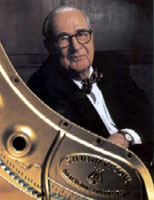 Henry Z. Steinway, former president of Steinway & Sons and great grandson of the firm’s founder, died on September 18, 2008 at the age of 93. He was the last Steinway to run the piano-making company his family started in 1853. In 2003 when Steinway & Sons celebrated its 150th anniversary at Carnegie Hall, he represented the family.
Henry Z. Steinway, former president of Steinway & Sons and great grandson of the firm’s founder, died on September 18, 2008 at the age of 93. He was the last Steinway to run the piano-making company his family started in 1853. In 2003 when Steinway & Sons celebrated its 150th anniversary at Carnegie Hall, he represented the family.Henry Z. Steinway is survived by his widow, Polly Zinsser, his sister Lydia Steinway Cochrane, and his five children.
183 Years of Piano Making
Heinrich Engelhard Steinweg (1797 – 1871) was a German piano manufacturer and the founder of Steinway & Sons. He was born in Wolfshagen im Harz, Germany. In 1835 he made his first square piano, which he presented to his bride Juliane at their wedding. In 1836 he build his first grand piano in his kitchen in the town of Seesen. This piano was later named the “kitchen piano”, and is now on display at the New York Metropolitan Museum of Art with a Steinweg 1836 square piano.
Going NY
Owing the unstable political climate in Germany, Steinweg decided to leave the country. He emigrated from Braunschweig, Germany, to New York City in 1851 with four of his sons, but before leaving he turned the German Company over to his son, Theodor Steinweg. Once in New York, he anglicized his name to Henry E. Steinway, and he and his sons worked for other piano companies until they could establish their own production under the name of Steinway & Sons in 1853. The business expanded with their inventions. The overstrung scale in a square piano earned the Steinway Piano a first prize at the New York Industrial Fair of 1855.
Its early successes have been credited both to the high quality of its instruments and to brilliant marketing, including the showroom and the Steinway Hall. Steinway Street, one of the main streets in the Astoria and Long Island City neighborhoods of Queens, is named after the company. The second factory was established in 1880, in Hamburg, Germany.
I'll Have a Hamburg D, Please
Many of the great pianists of the past (referred to by Steinway as ‘the Immortals’) and many active concert pianists today have expressed a preference for either the New York or the Hamburg piano. Vladimir Horowitz played a New York model D, Arthur Rubinstein preferred the Hamburg model D. Sergei Rachmaninoff had two New York Steinways in his Beverly Hills home, and one New York D in his New York home, and later he chose a Hamburg D for his new villa Senar in Switzerland.
The difference between the New York and Hamburg instruments is less noticeable today, although some objective differences are well known: the American models have a black satin finish and square or Sheraton corners; Hamburg models have a high gloss polyester finish and rounded corners.
550,000 Pianos during the 20th Century
By 1900, both factories were producing more than 3,500 pianos a year, for concert halls, schools, and private homes all over the world.
In 1857 Steinway began to produce a line of highly lucrative art case pianos, designed by well-known artists, which became popular among the rich and famous. Today, these pianos sell for vast sums of money at auction houses. In 1903 the one hundred thousandth Steinway grand piano was given as a gift to the White House. It was replaced in 1938 by the three hundred thousandth, which remains in the White House to this day.
During the 1920s Steinway had been selling up to 6,000 pianos a year. Piano production fell after 1929, and during the Great Depression they produced just over 1,000 pianos a year. In the years between 1935 and WWII, demand rose again.
By the year 2000, Steinway had made its five hundred and fifty thousandth piano. The company updated and expanded production of its two other brands, Boston and Essex pianos, in addition to the flagship Steinway & Sons. More showrooms, and large and small concert halls were opening across the world, mainly in Japan, Korea and China.
21st Century
At present, 2,500 Steinway pianos are built in New York every year, and 1,500 Steinway pianos are built in Hamburg. The market is loosely divided into two sales areas, New York Steinway supply North and South America with their pianos; Hamburg Steinway supply their pianos to the rest of the world. At all the main Steinway showrooms, pianos can be ordered from both factories. The New York and Hamburg factories exchange parts and craftsmanship in order to “make no compromise in quality”, in the words of Henry E. Steinway. Steinway parts for both factories come from the same places: Canadian maple is used for the rim; the soundboards are made from Sitka spruce from Alaska. Both factories use similar crown parameters for their diaphragmatic soundboards. Recently Steinway has acquired some of its suppliers in order to maintain quality: the German manufacturer Kluge in Wuppertal, which supplies all the keyboards was bought up in December 1998; in November 1999, it purchased the company which supplies its iron frames, O. S. Kelly Co., Springfield.
Immortal Beloved
Since 1996 Steinway Musical Instruments, Inc. has been traded on the New York Stock Exchange (NYSE). Its ticker name is LVB (Ludwig van Beethoven).
Links:
Steinway & Sons: Remembering Henry Z Steinway
A Salute to Henry Steinway (2006) by pianist Richard Glazier